DANCE CLASS
CONTENTS: PAGE 1 | PAGE 2 | PAGE 3 | PAGE 4 | PAGE 5 | PAGE 6
EDUARDO PINTO
(director, Palermo Hollywood):
Shooting creates a state of excitement in me. A journey to the most precious place: the story and its credibility. And a story can only grow if it has feeling. Feeling the character’s conflicts, relating to them, trying to experience the same with each story we tell. That was my biggest learning experience. The language of film is at the service of these feelings. In this, the actors are essential. They bring the story to life. I used to think of actors as objects, that I had absolute power to take them where I wanted. But I learned that the journey is done together. The framing, editing, sound or music are important, but if the actor does not “feel,” the image is empty, and the story cold, unfinished. That was a huge learning experience for me.
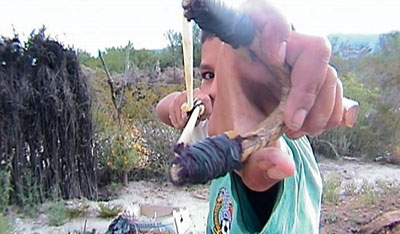 |
| Tropic of Cancer |
(director Tropic of Cancer):
The common lands of “Charco cercado” are located in the semi-desert areas of the state of San Luis Potosi, Mexico, at the latitude of the Tropic of Cancer. The people that live there, like those of several bordering villages, subsist under conditions of misery and abandonment. This forces them to go hunting and gathering in an arid and delicate environment inhabited by many types of birds, falcons, deer, rats, serpents, turtles, cacti, etc. Children and male adults design techniques and build tools such as slingshots and cages to go around hunting under the intense sun, and between huge cacti’s thorns, poisonous serpents, and many other risks. Hunger is, in fact, their main worry. So, aside from eating some of what they hunt, they transport it to the shore of the highway that crosses the area. There, a few meters from the passing of numerous trailers at great speed, women and little children wait from down to dusk under a heavy sun and covered only by some carton papers for some of the curious travelers that sometimes make a fast stop to buy the flora and fauna of this exotic zoo.It is in this moment when all the characters are together and the products of nature are bought for some money.
Those who live under conditions of misery are forced to subsist exploiting the natural sources of our environment. They share the same worry as those who went hunting and gathering in the Neolitic era:the need to survive. Then I would say that we are petrified in time
The Semi-desertic area of the state of San Luis Potosi is located in central Mexico. SLP is called the heart of Mexico because it borders with ten states, and Highway 57, the most important trade route of the country passes through it.
Tropico de Cancer could be described as a shout of silence.
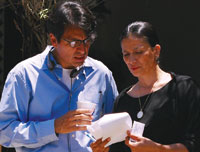 |
| Between |
(director, Between)
What a fascinating job it is to be a filmmaker. God, let me make many more movies! To be a leader, motivator, collaborator and visionary all in one is truly inspirational. In my first feature, Between, I set out to create an atmosphere of collaboration, encouraging everyone to bring on ideas without holding back. I wanted everyone to feel they had a stake in the film. I’ve learned that it takes a team of motivated people to realize your vision. It’s always wise to carefully choose with whom you work on your project. It’s not enough for the cast and crew to be talented, they have to be enthusiastic and truly believe in your film for it to be successful.
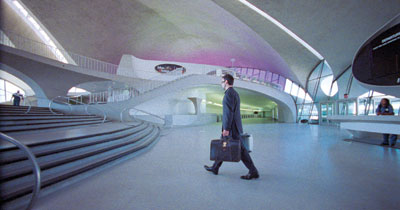 |
| Mitchellville |
(writer-director, Mitchellville)
Because Mitchellville was my first film — feature, short, student or other — I had no idea how my words would translate to the screen. Would the action be too slow, the characters too precious, the story too subtle, the visuals too stylized?
After watching the dailies during a break in shooting, I discovered moments when the action, the dialogue, the characters, the story, the visuals, joined together in brief, but quite startling, and perhaps unexpected, moments. Against these moments were others that rang false in large measure because they departed from those that rang true. This knowledge, gained relatively early in the process, proved invaluable when I resumed shooting, allowing me to shape the film towards those discovered moments.
In the end, I do not know whether I have discovered my style, or have discovered simply the style for Mitchellville. Regardless, I believe now that good films have this core, this sensibility, this truth, which is the director’s challenge to define and create.
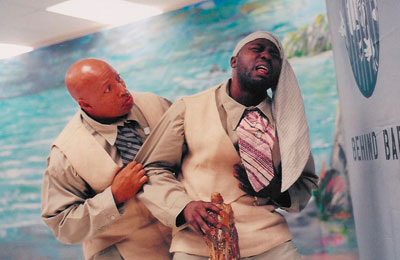 |
| Shakespeare Behind Bars |
(director, Shakespeare Behind Bars):
When we finished filming, we of course had exhausted our funding sources as well as our credit cards. Needless to say, there was a lot of “down” time between production wrap and post. Like, “will we ever finish this film?” down time. So, after I had looked at most of my footage, I decided I would try to edit some scenes together myself — on a “whenever I could find the time” basis — to show to potential buyers (as well as potential editors). Over the course of four months, I came up with a new stage of the production process for myself: “The Director’s Pre-cut.”
By cutting together some footage, I had the opportunity to get a feel for the raw material, and an idea of the challenges my editor and I would face. It also helped me write the film, since it gave me an idea of how to best integrate the plot of Shakespeare’s The Tempest, how different scenes and locations might work, and which characters would complement each other. In general it gave me more of an idea of the overall flow and tempo for the film. And in the end, some of those scenes made the final cut.
DOUG SADLER
(writer-director, Swimmers):
One of the things I found personally exciting about making Swimmers was the way in which a disparate group of strangers (cast and crew) galvanized into a team determined to support a story which I had dreamed up over a number of years. During the course of production we faced more than our fair share of “challenges” (both natural and man-made), and I was consistently surprised, humbled and encouraged by the passion and determination with which the cast and crew responded.
I’ve spent some time thinking about how that spirit came to be. The conclusion I’ve come to is that it has to do with the infectious nature of the initial manic spark that sets any filmmaker off on the twisting, sometimes torturous path of making a film. If that spark can be shared in a way that allows others to contribute creatively, to feel they are involved in something worthy, the benefits are enormous. It can be very heady to step onto a set where you’re “in charge,” but that can be a trap because it’s really not the director’s role to know everything (and it’s dangerous to pretend to). Rather it’s the director’s role to hold that original spark, set it alight in others then manage the flames.
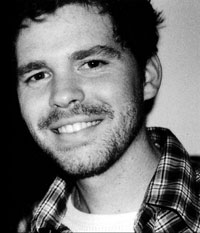
director Craig MacNeill | CRAIG MACNEILL
(director, Late Bloomer): Late Bloomer being my first film, I was nervous and uncertain of how things were going to unfold during the shoot. As a result of that uncertainty, I was constantly aware of my actions and decisions and learned a great deal about myself. In particular, I discovered that I have the ability to thrive under stressful circumstances. Confronted with the severe time restraints and stress of the process I strived to remain calm, focused and confident, and I think that awareness comes through in the film. |
CONTENTS: PAGE 1 | PAGE 2 | PAGE 3 | PAGE 4 | PAGE 5 | PAGE 6
VOD CALENDAR


 See the VOD Calendar →
See the VOD Calendar →


